THE TWIN SAINTS of MEDICI: SS MEDICI- COSMA & DAMIANO. BROTHERS, SAINTS & MARTYRS
Posted: May 28, 2020 Filed under: Angela's picture galleries, East Harlem, East Harlem Events, FYI, Italian Americans, Italian East Harlem, NEW YORK ITALIANS, Vintage Photography | Tags: 1942, cosma, damiano, East 117th Street, feast day, martyrs, ss medici, twin saints 10 CommentsAfter I posted the photos, yesterday, of the Feast of SS Medici, of 1942, which was located on the 400 block of East 117th St. in East Harlem, I began to think about these saints, and what they meant to all of these people who gathered to venerate them. I googled them, and found lots of interesting information.! Here’s the scoop:
First, they were born in what is now known as Syria, in 260 A.D., and died in Syria, as martyrs circa 303, AD. They were excellent medical doctors, that never accepted monetary payment for their services. Their feast day occured on the 27th of September, at that time. Also, how they died is unbelieveable! (It’s worse than watching an episode of “The Blacklist.”) I found some interesting facts, on an Italian website, which describes how they were tortured on 5 separate occasions. On the 5th try, they were beheaded and finally died. Here is the excerpt, which is not for the faint of heart. Lol:
…After arrest and trial, the Saints were subjected to a series of cruel tortures, in the vain hope of making them withdraw from their firm resolve. As a first punishment, the flogging was imposed on them. Since the executioners were unable to apostatize them, tied hands and feet they were thrown into the sea by a high ravine with a large boulder hanging from the neck, to facilitate their sinking. Miraculously, however, the ties melted and the holy brothers surfaced on the surface safely, welcomed to the shore by a crowd of festive faithful, thanking God for the extraordinary event. Arrested again, they underwent other painful trials. Led before a burning furnace, they were immersed in the fire tied with sturdy chains. The flames, however, did not consume those holy limbs, that they came out once again unscathed and the fear of the soldiers in custody was such as to force them to flee precipitously. The book of the “Martyrology” informs us that “Saints Cosma and Damiano were martyred five times”. In fact, they went through the tests of drowning, of the burning furnace, of stoning, of flagellation, to end their earthly days with martyrdom in the year 303. http://www.brattiro.net/SS%20COSMA%20E%20DAMIANO/la_vita_dei_santi_medici_cosma_e.htm
Here’s another interesting excerpt from Italy Magazine:
…They might be two of the lesser-known saints of the Roman Catholic Church, but “I Santi Medici,” the Doctor Saints Cosma and Damiano are two of the most celebrated within the Bel Paese. On 26 September, places such as Gaeta (south of Rome), Taranto (Puglia), and Sferracavallo (outside of Palermo) hold various celebrations for these patron saints of doctors, pharmacists and surgeons.
The twin brothers were born in present-day Syria and quickly became known for their healing ways for which they accepted no payment; for this refusal, they are often called the “Silverless” or “Moneyless.” While practicing medicine, they also shared their Catholic faith with patients and gained a wide following.
Just like San Gennaro of Naples, Sts. Cosmas and Damian became martyrs during Diocletian’s persecution of Christians around 300 A.D. The twins, though subjected to torture using fire and water and were even placed on crosses, wouldn’t recant their faith. When the two remained miraculously uninjured through the ordeals, Diocletian ordered their beheadings.
Their remains were buried in Syria, and churches in their honor were built in their home country as well as in Jerusalem, Egypt, Mesopotamia and in Rome by Pope Felix IV; the sixth-century Basilica dei Santi Cosma e Damiano holds several valuable mosaics, and the twin doctor saints are still revered throughout Italy and the world. https://www.italymagazine.com/featured-story/celebrating-patron-saints-physicians
Isn’t this fascinating stuff? I’m so grateful to Michael, one of my readers, who so graciously shared these wonderful vintage photos with me, and the rest of my readership! As the old saying goes, “every picture tells a story”. Well, in my opinion, the photos of the twin saints have so very much to tell! For instance, I wonder if the people that lived on East 117th Street, were primarily from the region of Puglia? I’m curious because, I read that these saints are venerated within that region of Italy. There are shrines for these saints in Madrid, Rome, and Bari, Italy. So, perhaps, there was a large population of East 117th Street, that immigrated from Bitonto, Bari, Puglia, Italy. Also, now I know the probable date of the East Harlem feast photos. We know the year, 1942, but now we know the date as well. It was Sunday, September 27th, which was the official feast date, according to the General Roman Calendar, pre-1970. Any thoughts?
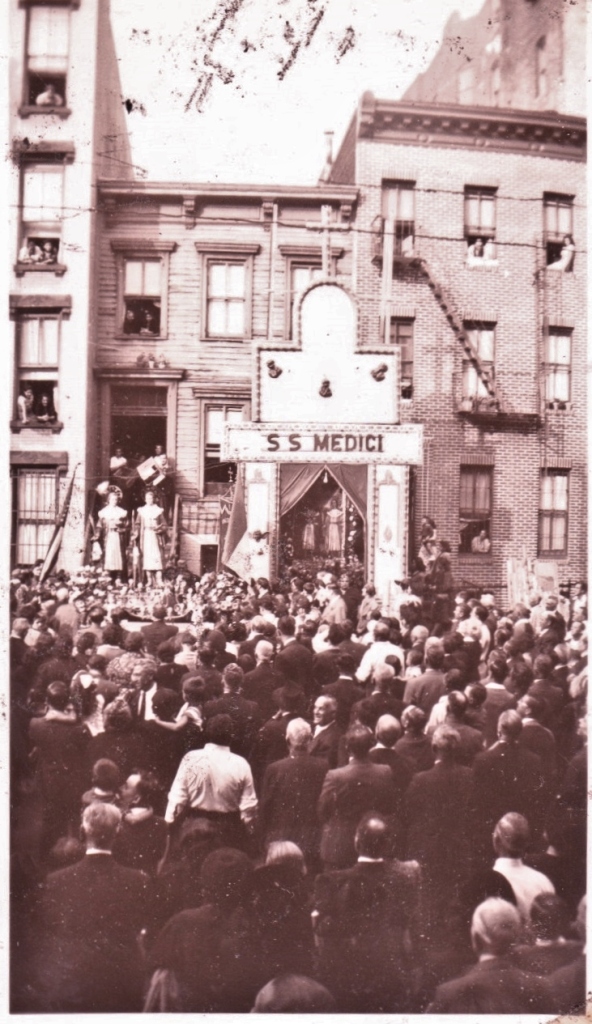
Sunday, September 27th, 1942. The 400 block of East 117th St., East Harlem.
Rare Photos of the “Festa di Madonna di Monte Carmela” of East Harlem-July 16, 1942.
Posted: May 27, 2020 Filed under: Angela's picture galleries, Churches of East Harlem, East Harlem, Italian Americans, Italian East Harlem, New York City, NEW YORK ITALIANS, Vintage Photography | Tags: 1942, AIEH, sepia, vintage, vintage photographs, Vintage Photography, vintage photos 13 CommentsPhotos courtesy of Michael G. (I took the liberty to edit them a bit, just to give them some more definition.) The photographer that took these wonderful photos was Michael’s great uncle, Antonio Scelza, of 424 East 117th Street, in East Harlem. Thank you so much for sharing these amazing photos, Michael! Enjoy them!
Note: After you click on the above image, look in the lower right hand corner, to click on the words “view full size.” Then, you can click again to zoom in to see more detail!
Note: After you click on the above image, look in the lower right hand corner, to click on the words “view full size.” Then, you can click again to zoom in to see more detail!
Antonio Scelza, photographer.
Note: After you click on the above image, look in the lower right hand corner, to click on the words “view full size.” Then, you can click again to zoom in to see more detail!
Note: After you click on the above image, look in the lower right hand corner, to click on the words “view full size.” Then, you can click again to zoom in to see more detail!
Note: After you click on the above image, look in the lower right hand corner, to click on the words “view full size.” Then, you can click again to zoom in to see more detail!
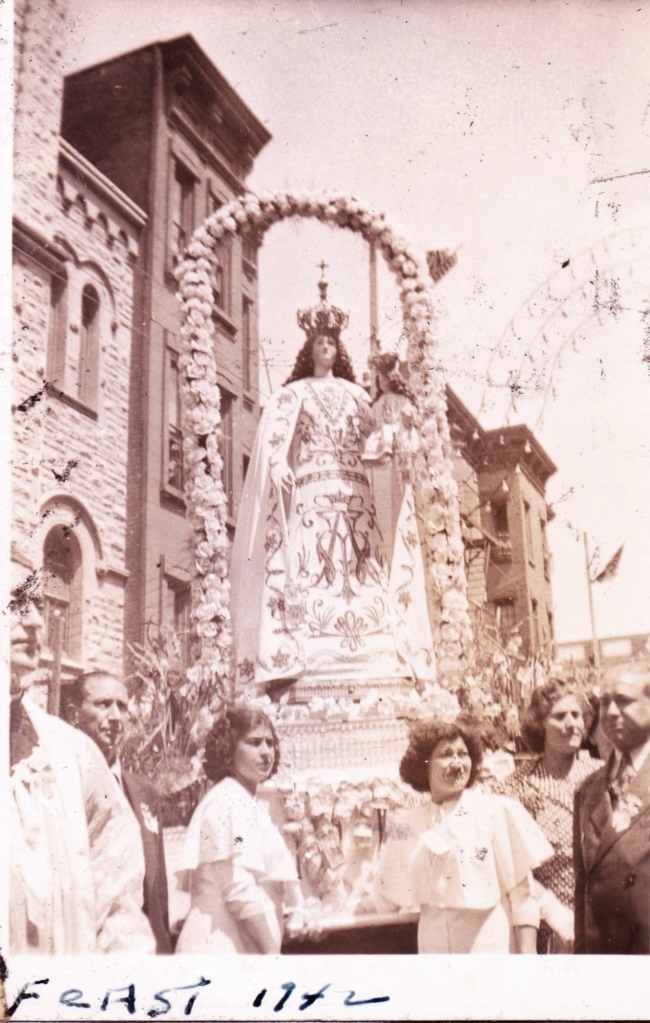
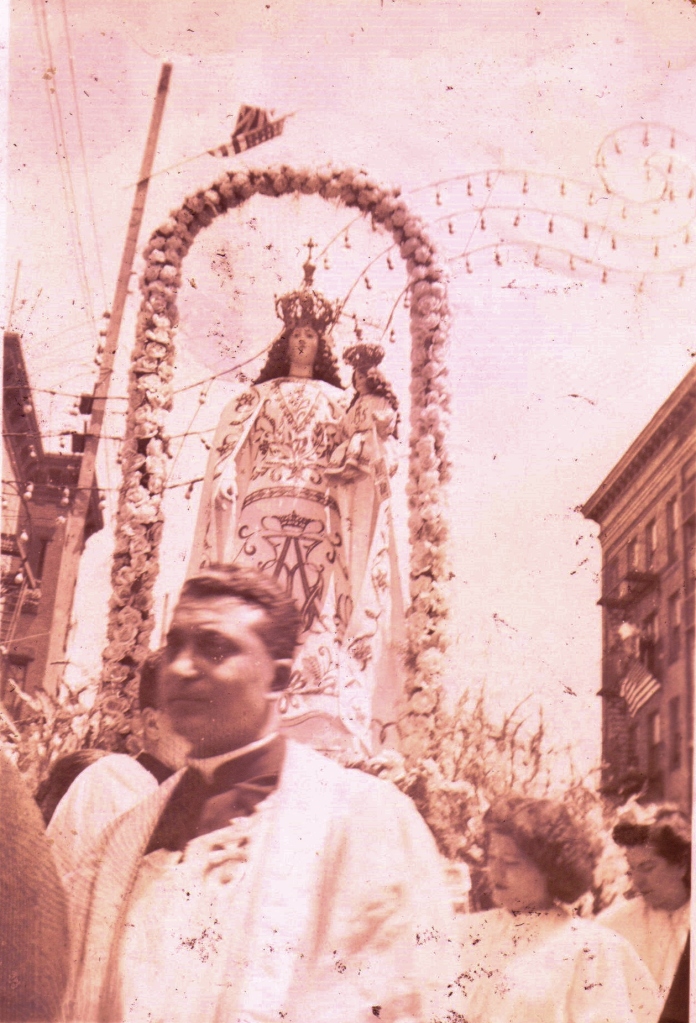
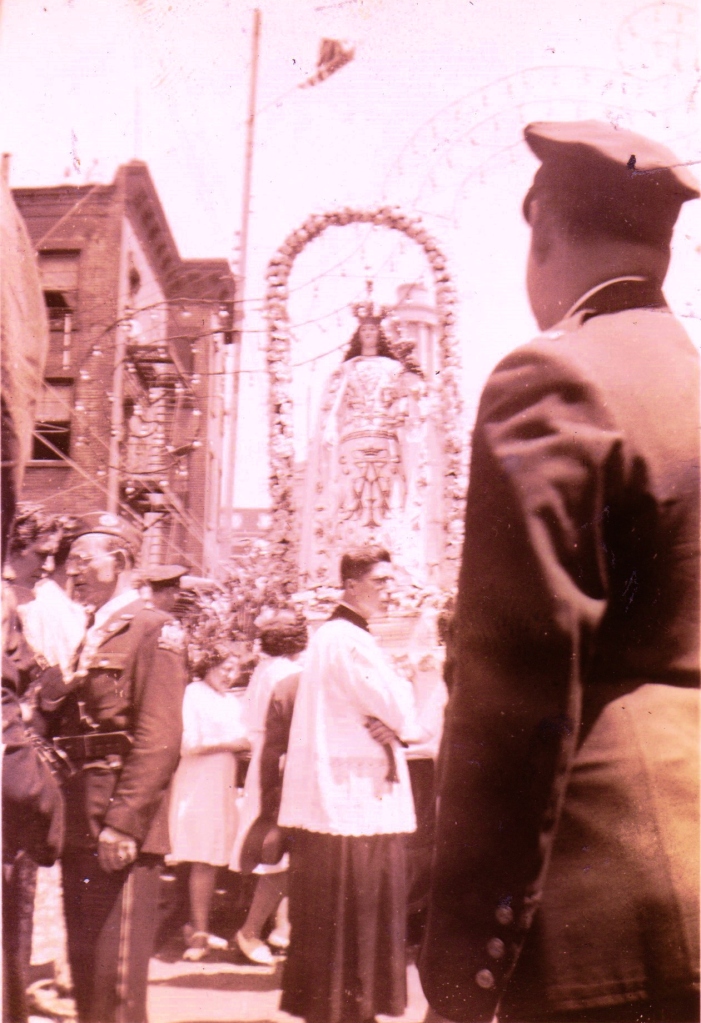
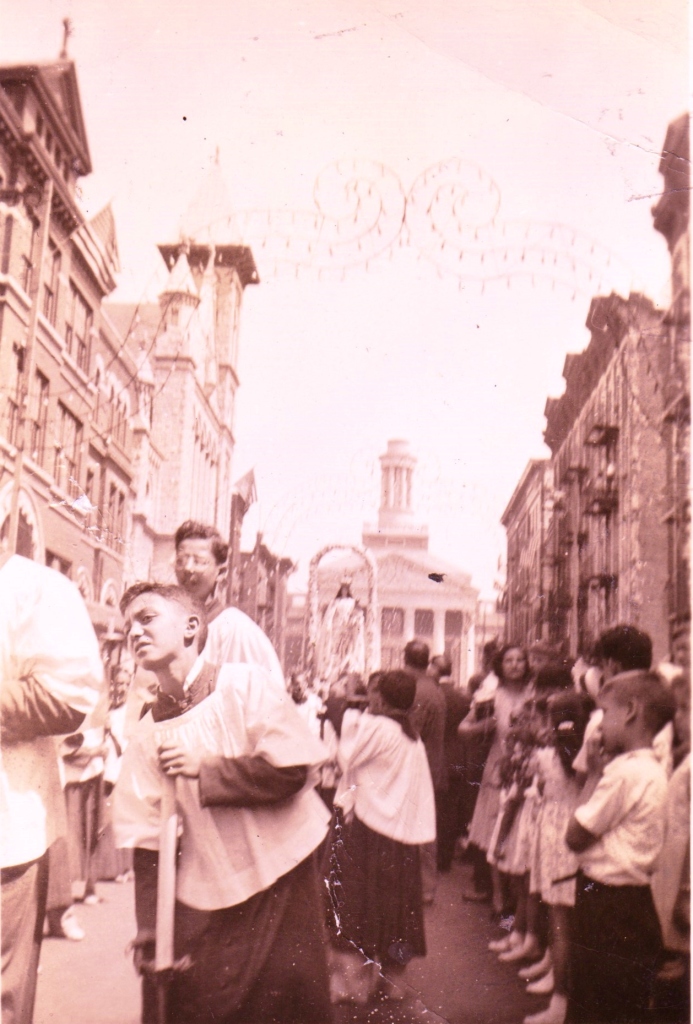
Our Lady of Mt. Carmel Procession. East 115th Street. July 16, 1942. Notice the OLMC church, in the background, on the left. Also, the newly-erected Benjamin Franklin High School is in the center background .
Note: After you click on the above image, look in the lower right hand corner, to click on the words “view full size.” Then, you can click again to zoom in to see more detail! You can click on each individual photo to view it in full format.
“A BETTER TOMORROW” 1945 filmed in East Harlem
Posted: May 26, 2020 Filed under: But Not Forgotten!, East Harlem, East Harlem Maps, Italian Americans, Italian East Harlem, Movies Filmed in East Harlem, New York City, NEW YORK ITALIANS, Pleasant Avenue, Tenements, Video | Tags: archive, archives, Benjamin Franklin High School, East Harlem, film, Leonard Covello, video, vintage 5 CommentsThe Historical Society of Pennsylvania is holding a collection of photos, files, and ephemera that belonged to Leonard Covello, the former principal of Benjamin Franklin High School. As kismet would have it, I stumbled upon an extremely rare, short film, filmed by Alexander Hammid, a Czech film director, and cinematographer. Technically, for all intents and purposes, this was a US government propaganda film. I’m not a fan of some of the statements that were made in this film, but it’s a fabulous “portal to the past”, and that’s good enough for me! This is a short film on American public education, intended for public use. It was filmed in 1945, in several New York City locations, with a special focus on Benjamin Franklin High School, located on Pleasant Avenue in East Harlem. I cropped the film to reflect what I would prefer to emphasize-which is daily community life in East Harlem. Oh, and you’re welcome! (wink) 🙂 If you wish to view this film in its entirety, here’s the direct link: https://digitallibrary.hsp.org/index.php/Detail/objects/13235
I must tell you that I have a personal collection of rare papers, photos, letters, and maps-some of which are shown in this film. Long story, but I’ll tell you a bit about how I acquired them. About 5 years ago, I received a phone call from the wife of a bookseller that I frequently bought from. I was asked if I would like to have the remainder of files from the archives of Leonard Covello. I was stunned! I had been searching for years, scouring the planet for anything remotely related to the East Harlem community, and in one phone call, I was given a fabulous gift! The book seller’s name is Michael Cordasco. Michael’s father, Francesco Cordasco, was a well known sociologist, Columbia graduate, and a close friend and colleague of Leonard Covello. When Leonard Covello died, Francesco was given Covello’s files, books, photos, etc. Most of the Covello collection went to the Historical Society of Pennsylvania, and, with sheer luck and serendipity, the rest went to yours truly! I will never forget that afternoon, when I received that phone call! I’ll post a video soon, talking more about how I acquired the collection. 🙂
I have been meaning to digitize my collection, for years now, but found it difficult to set aside the time to do so. Also, I’m a terrible procrastinator! Ha ha, there, I said it! 🙂 Now, due to the Covid-19 situation, I am not working outside my home, so I have the time to move forward with my digitization and preservation project. Aside from the Covello collection, I have a huge archive of “all things East Harlem” that I have been collecting since 2004. I also have a large photo library of vintage photos that were given to me by family and friends, and I have ephemera which relates to East Harlem as well. Oh, I haven’t mentioned the books, which I have been scouring the internet to find, for almost 15 years!
There’s so much for me to do. When I think about it, I get overwhelmed! Lol However, the clock is ticking, and I owe it to my readership, and to my East Harlem ancestry, to get the ball rolling! 🙂
So, watch this movie, and if you click through to my YouTube page, don’t forget to follow me! Oh, and if you are so inclined, watch my metaphysical videos on crystals, astrology, numerology, tarot, and all that fun stuff! Yes, I wear many hats! Lol 🙂
ON THE CORNER OF E. 110th Street & 1st Avenue-1936 & 2016
Posted: May 26, 2020 Filed under: Angela's picture galleries, But Not Forgotten!, digital photography, East Harlem, Gone, Italian Americans, Italian East Harlem, New York City, NEW YORK ITALIANS, Vintage Photography | Tags: depression era, vintage photographs, vintage photos 2 CommentsMy paternal grandfather, Antimo, aka Tony Puca, is seen on the right, wearing the dark pants and shirt, with suspenders. He lived with his wife and 7 children, in his mother’s building, at 346 E. 110th Street. His son, my uncle Philly, is seen in the foreground. Philly was born in 1926, so I estimated that this photo was taken around 1936-38. My grandfather was a produce vendor. He sold fruits and vegetables on that spot, on the north side of E. 110th, and on 1st Avenue, between E. 110th and E. 111th. My dad told me that sometimes, they had the pushcart on the opposite corner, between E. 110th & E. 109th-on 1st Avenue. Notice the tomato plants in the foreground, on the right. Also, seen holding on to the iron fence of the Metropolitan Gas Company, later known as Consolidated Edison, is my grandfather’s friend, Vincenzo, who was also my uncle Philly’s godfather. The man in the middle is unknown to me, although it looks like he is wearing an apron, so maybe he was a food vendor, selling hot foods on a pushcart. Also, notice the man in the background, wearing a suit and hat. It looks like he was interested in buying the tomato plants. Well, I hope my grandfather had a fruitful day on that memorable day in Italian Harlem! 🙂
Note: If anyone recognizes the man wearing the light colored hat, and apron, standing in the middle of this photo, let me know!
The modern day photo is from 2016. I took my aunt Tessie to visit the old neighborhood. She hadn’t been back in over 50 years, so, believe me, that indeed was a memorable day! Today, as you can see from the modern photo, there is a brick wall placed further out where the iron fence once stood. There are no vendors to be seen. No vestiges of ancestral bygone days. No tomato plants. No old friends. Sadly, just an empty sidewalk. I’m sure that there are days when there is more foot traffic, but on that weekend spring day, in April of 2016, it was quiet.
P.S. Isn’t it cool that the large building in the background is still there? They have renovated it, but, as you can see, it is basically the same. Also, one more point…the street light from 1936 was a bit shorter in height than the one that is there now. I noticed that, as in the old photo, the top of the street light aligned with the 4th story of the large building in the background. Today, the street light that exists, lines up with the edge of the 6th story of that same building. Also, back in the day, that building was owned by the gas company. Today, it is a storage facility. Just a bit of trivia for you all! 🙂
ITALIAN POPULATION in EAST HARLEM-1930 CENSUS-Historical Facts and Figures
Posted: May 24, 2020 Filed under: digital photography, East Harlem, East Harlem Ephemera, East Harlem Facts and Figures, East Harlem Maps, Immigration history, Italian Americans, New York City, NEW YORK ITALIANS | Tags: facts and figures, maps, statistics 8 CommentsSo, historically speaking, where exactly did the neighborhood of East Harlem begin and end? Technically, the boundary started at 96th Street, from the East River, west to 5th Avenue, and heading North to 125th Street, but for all intents and purposes, the majority of the Italian district started well past E. 100th Street, and basically, started thinning out past E.125th Street.
Note: According to the 1930 Census, there were 5800 Italians living between E. 99th and E. 104th, from 1st Avenue to 3rd Avenue. Next, from East 104th to East 109th Streets, from 1st Avenue, heading west to 3rd Avenue, there were 15,500 Italians living in that zone. Moving North, from East 109th to 114th Street, there were 12,500 Italians living between Pleasant Ave., 1st and 3rd Avenues. And then, from East 114th Street, up to East 119th Street, between Pleasant Avenue, heading west to 3rd Avenue, there were 20,500 Italians living in that zone. This particular “Italian zone” is probably the largest, due to the fact that Pleasant Avenue was included in these population figures. Historically, Pleasant Avenue’s residential community started near Jefferson Park, from East 114th Street-near Rao’s, up toward East 125th Street. (However, past East 121st Street, near Pleasant Avenue (back in the day before the public housing development was built), that area was largely industrial in nature-up towards East 125th Street). Lastly, from East 119th Street, up to around East 125th Street, there were approximately 11,500 Italians living between Pleasant Ave. and 3rd Avenue. If you move West, from 3rd Avenue, up to 5th Avenue, there were thousands more Italians, starting from 91st Street, on the east side, and heading west and North to 5th Avenue and up past E. 125th Street! 🙂 Source: Casa Italiana Educational Bureau of Columbia University. (Leonard Covello was the Executor Director, at that time).

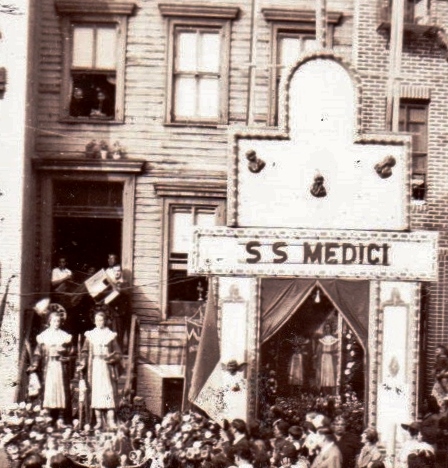
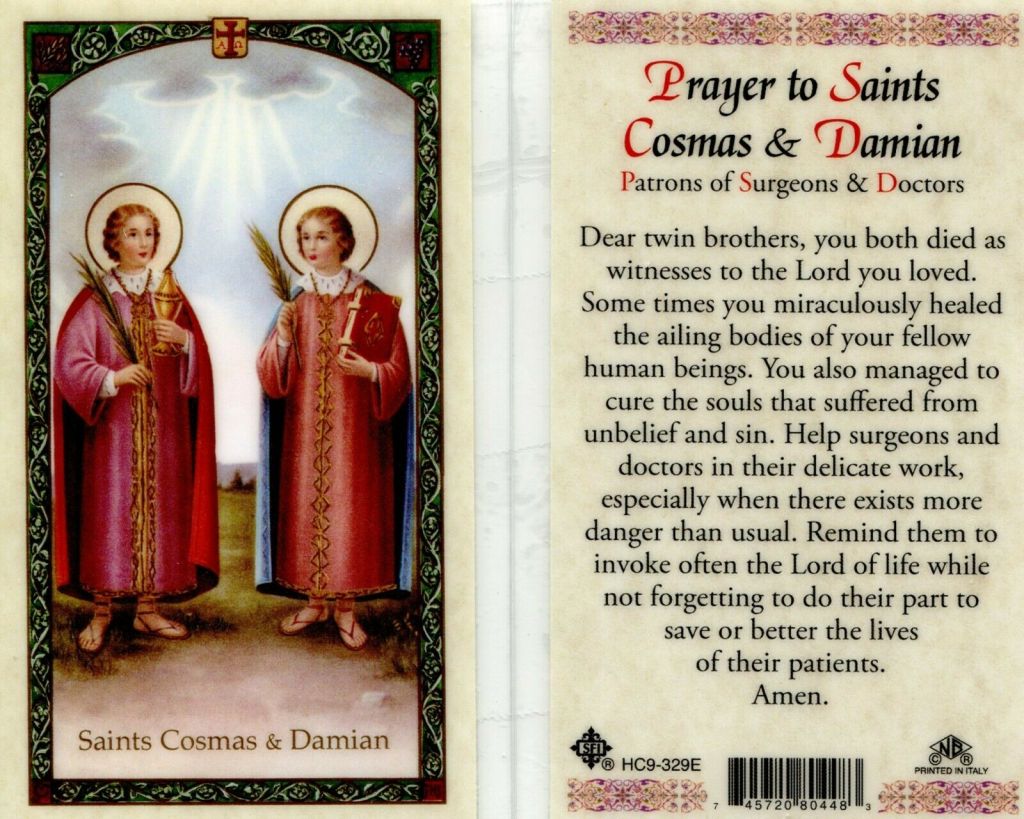
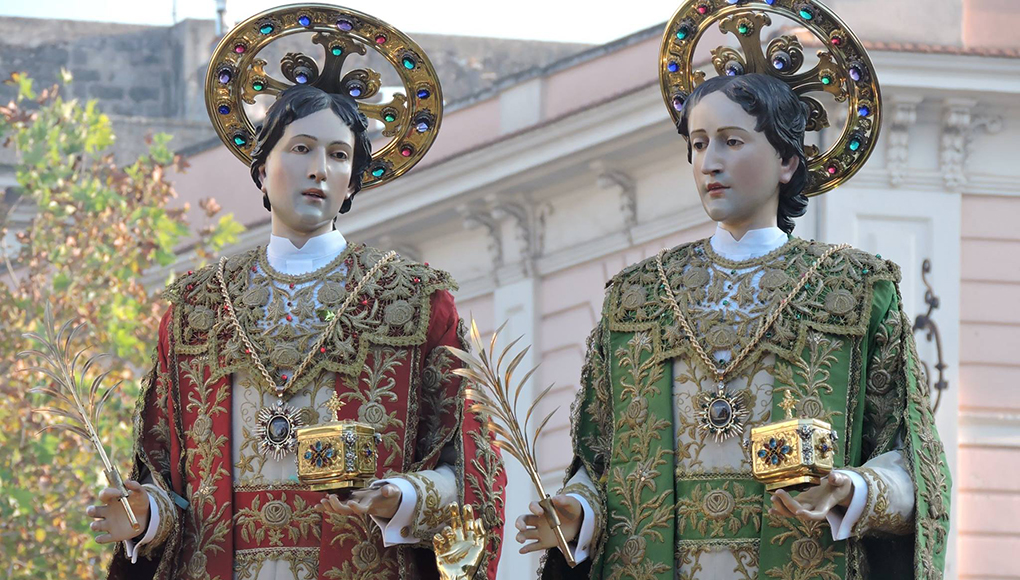
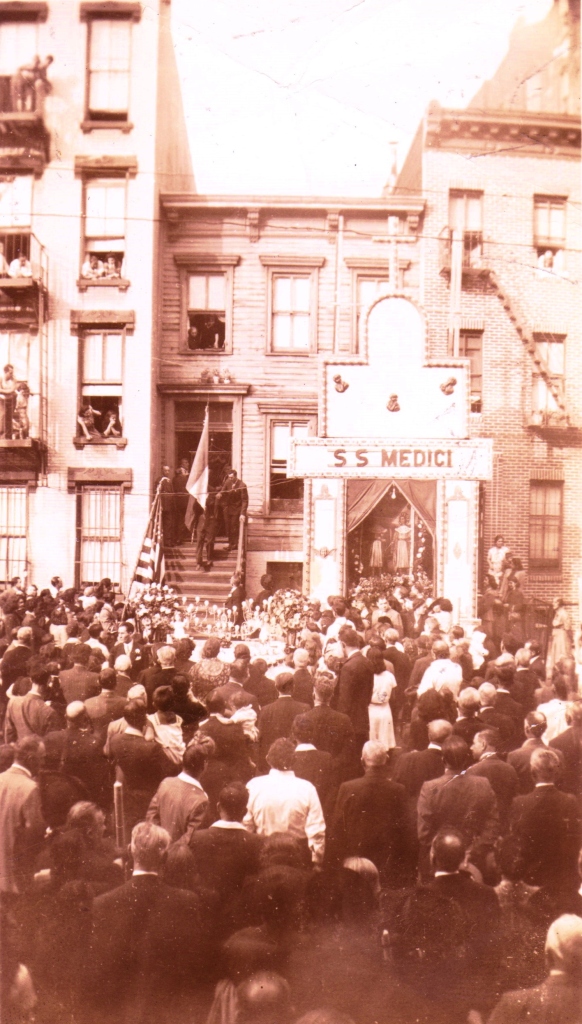
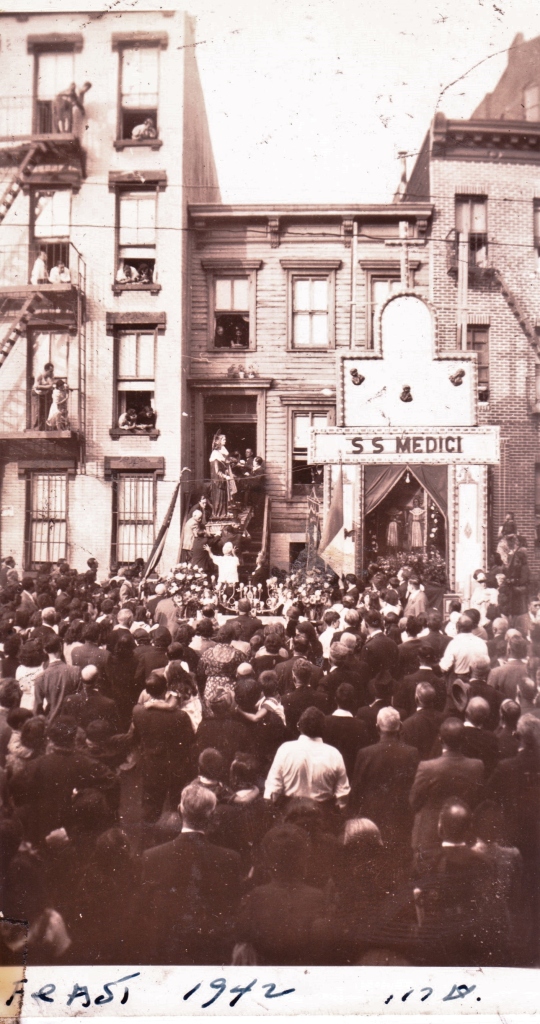
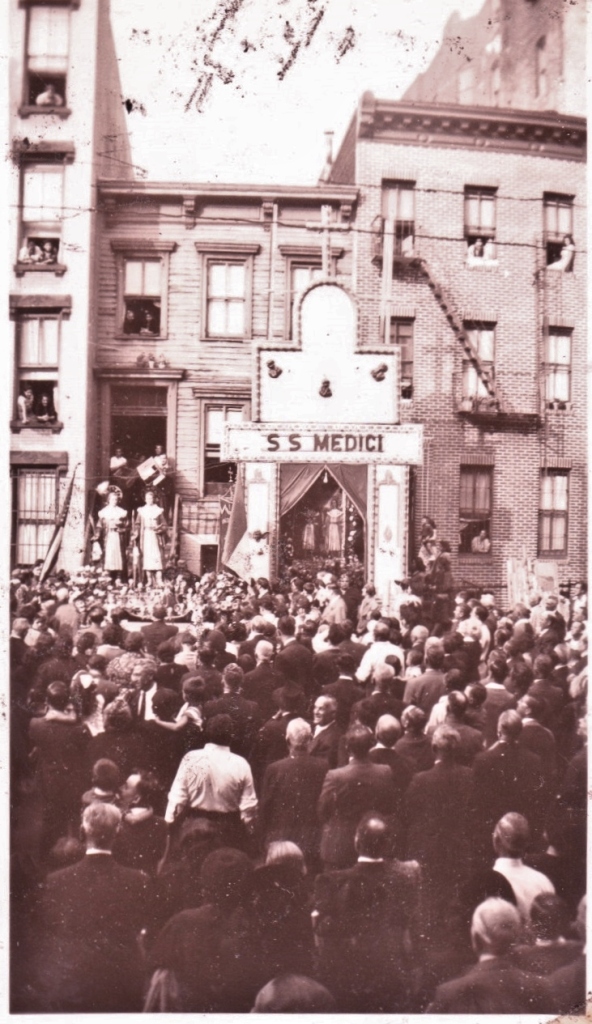
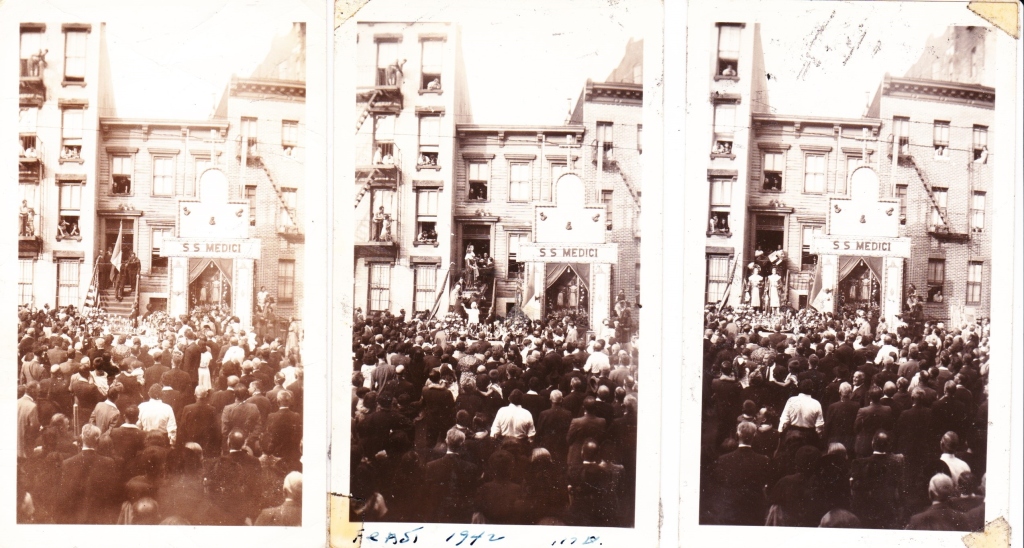
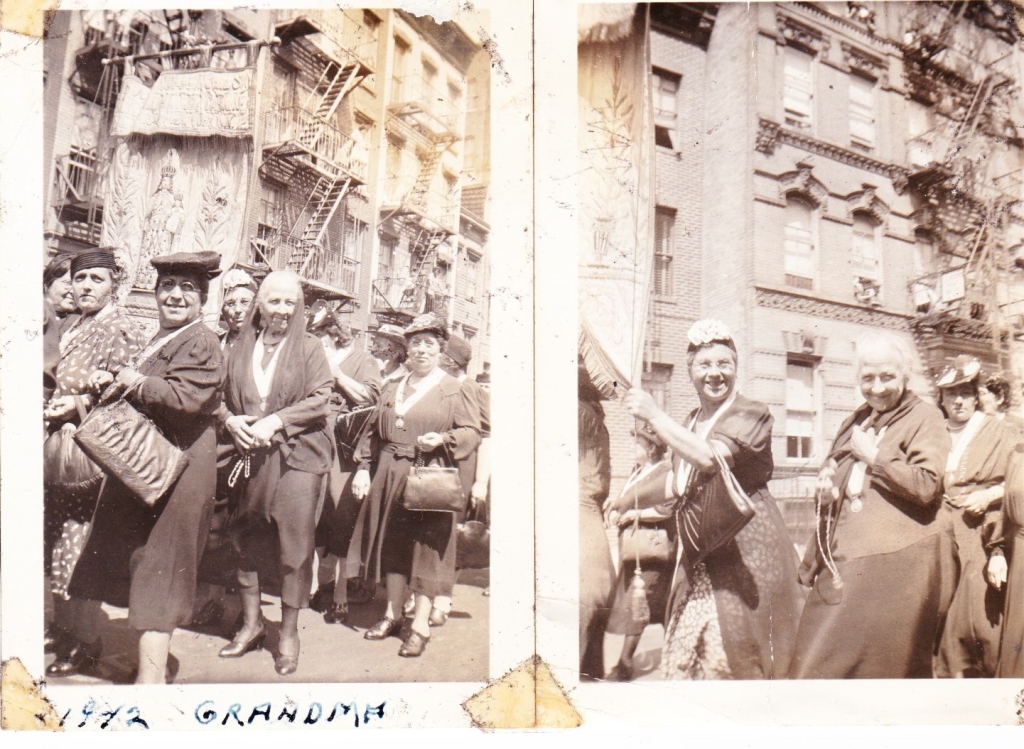
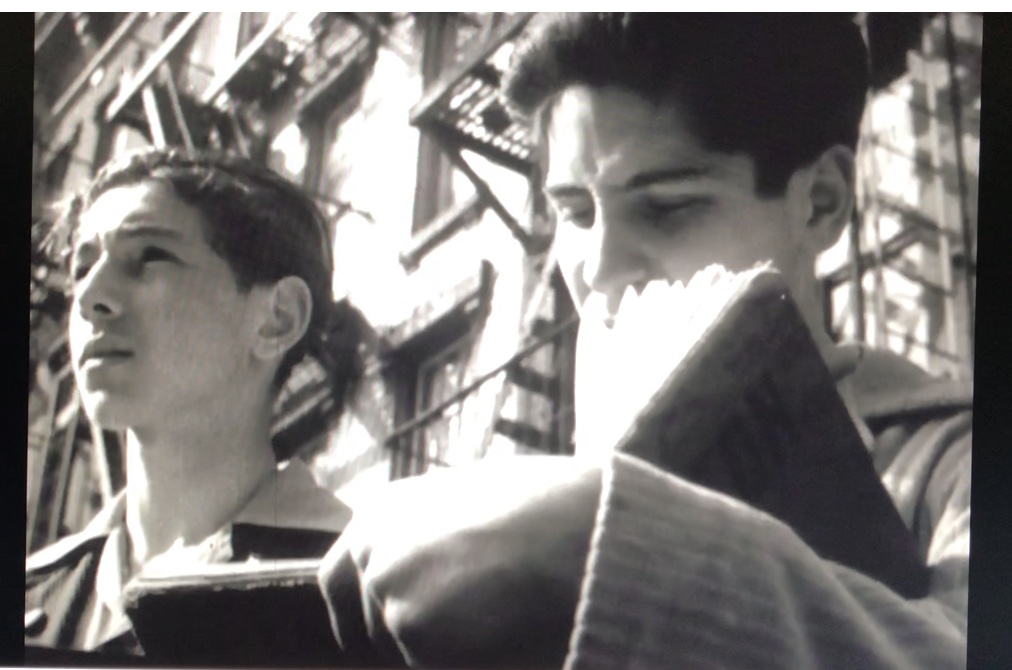


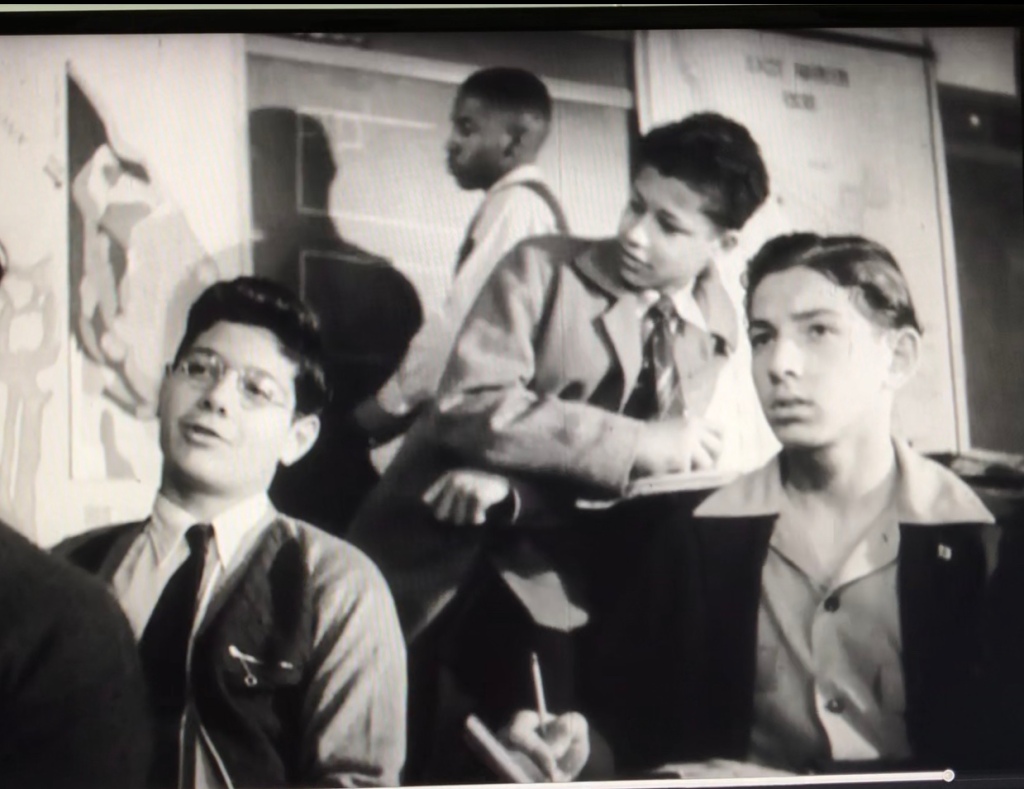
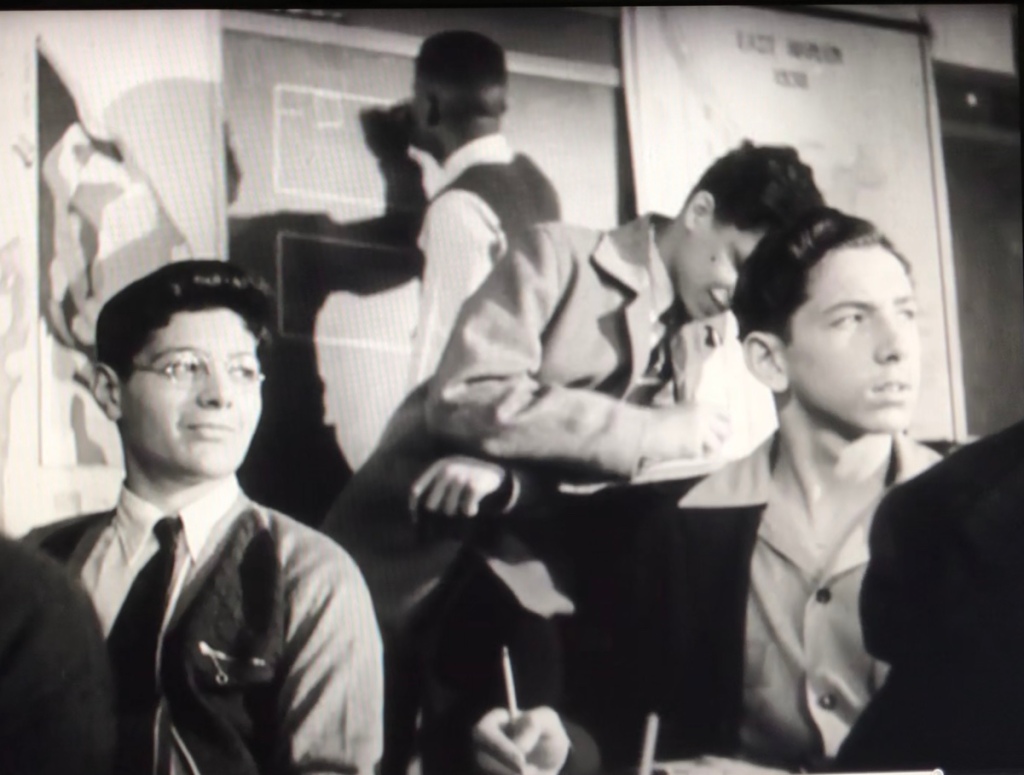








Recent Comments